2015 Alfa Romeo Giulietta window
[x] Cancel search: windowPage 57 of 288
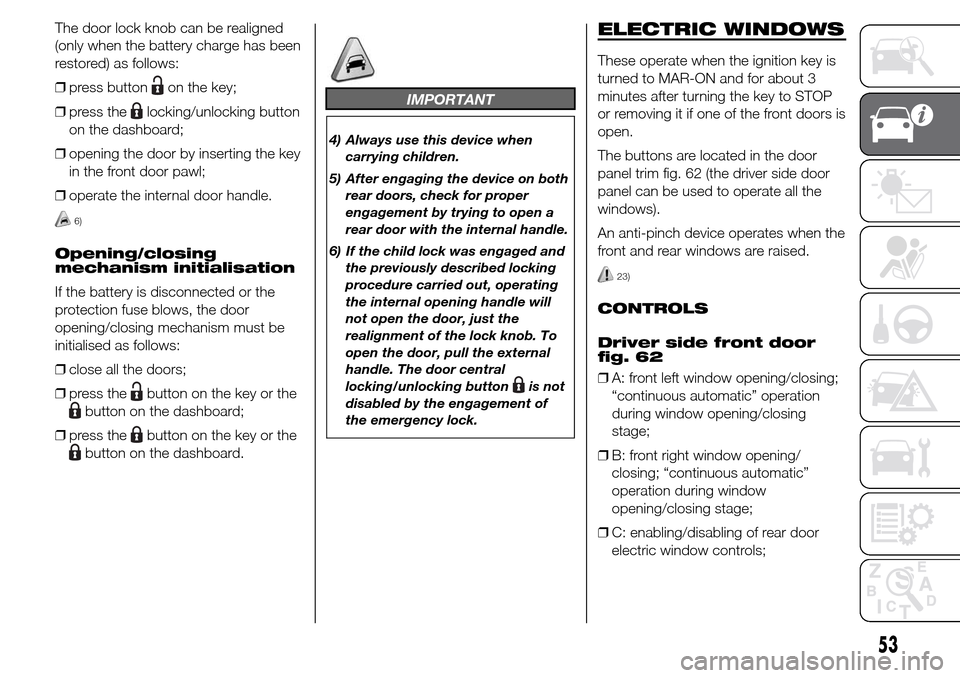
The door lock knob can be realigned
(only when the battery charge has been
restored) as follows:
❒press button
on the key;
❒press the
locking/unlocking button
on the dashboard;
❒opening the door by inserting the key
in the front door pawl;
❒operate the internal door handle.
6)
Opening/closing
mechanism initialisation
If the battery is disconnected or the
protection fuse blows, the door
opening/closing mechanism must be
initialised as follows:
❒close all the doors;
❒press the
button on the key or the
button on the dashboard;
❒press the
button on the key or the
button on the dashboard.
IMPORTANT
4) Always use this device when
carrying children.
5) After engaging the device on both
rear doors, check for proper
engagement by trying to open a
rear door with the internal handle.
6) If the child lock was engaged and
the previously described locking
procedure carried out, operating
the internal opening handle will
not open the door, just the
realignment of the lock knob. To
open the door, pull the external
handle. The door central
locking/unlocking button
is not
disabled by the engagement of
the emergency lock.
ELECTRIC WINDOWS
These operate when the ignition key is
turned to MAR-ON and for about 3
minutes after turning the key to STOP
or removing it if one of the front doors is
open.
The buttons are located in the door
panel trim fig. 62 (the driver side door
panel can be used to operate all the
windows).
An anti-pinch device operates when the
front and rear windows are raised.
23)
CONTROLS
Driver side front door
fig. 62
❒A: front left window opening/closing;
“continuous automatic” operation
during window opening/closing
stage;
❒B: front right window opening/
closing; “continuous automatic”
operation during window
opening/closing stage;
❒C: enabling/disabling of rear door
electric window controls;
53
Page 58 of 288
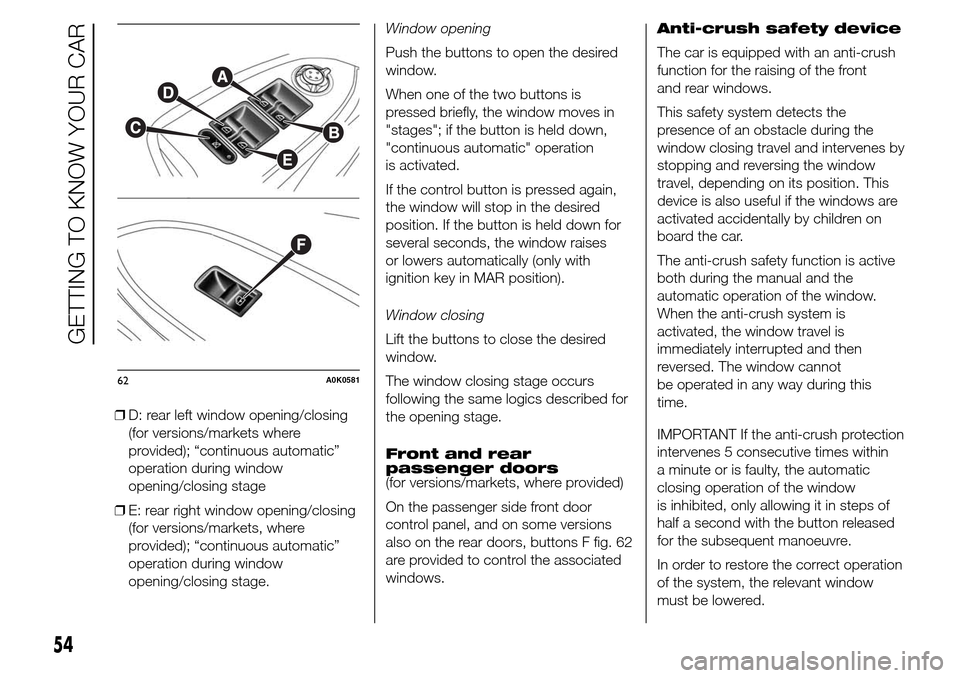
❒D: rear left window opening/closing
(for versions/markets where
provided); “continuous automatic”
operation during window
opening/closing stage
❒E: rear right window opening/closing
(for versions/markets, where
provided); “continuous automatic”
operation during window
opening/closing stage.Window opening
Push the buttons to open the desired
window.
When one of the two buttons is
pressed briefly, the window moves in
"stages"; if the button is held down,
"continuous automatic" operation
is activated.
If the control button is pressed again,
the window will stop in the desired
position. If the button is held down for
several seconds, the window raises
or lowers automatically (only with
ignition key in MAR position).
Window closing
Lift the buttons to close the desired
window.
The window closing stage occurs
following the same logics described for
the opening stage.
Front and rear
passenger doors
(for versions/markets, where provided)
On the passenger side front door
control panel, and on some versions
also on the rear doors, buttons F fig. 62
are provided to control the associated
windows.Anti-crush safety device
The car is equipped with an anti-crush
function for the raising of the front
and rear windows.
This safety system detects the
presence of an obstacle during the
window closing travel and intervenes by
stopping and reversing the window
travel, depending on its position. This
device is also useful if the windows are
activated accidentally by children on
board the car.
The anti-crush safety function is active
both during the manual and the
automatic operation of the window.
When the anti-crush system is
activated, the window travel is
immediately interrupted and then
reversed. The window cannot
be operated in any way during this
time.
IMPORTANT If the anti-crush protection
intervenes 5 consecutive times within
a minute or is faulty, the automatic
closing operation of the window
is inhibited, only allowing it in steps of
half a second with the button released
for the subsequent manoeuvre.
In order to restore the correct operation
of the system, the relevant window
must be lowered.
62A0K0581
54
GETTING TO KNOW YOUR CAR
Page 59 of 288

IMPORTANT With ignition key at STOP
or removed, the electric windows
remain active for about 3 minutes and
are deactivated when a door is opened.
IMPORTANT With the anti-crush
system, when the
button on the
remote control is pressed for longer
than 2 seconds the windows will open,
whilst if the
button is pressed for
longer than 2 seconds the windows will
close.
IMPORTANT
7) The system conforms to the
2000/4/EC standard concerning
the safety of passengers leaning
out of the passenger
compartment.
WARNING
23) Incorrect use of the electric
windows may be dangerous.
Before and during their operation,
ensure that any passengers are
not at risk from the moving glass
either by personal objects getting
caught in the mechanism or by
being hit by it directly. When
leaving the car, always remove
the key from the ignition to
prevent accidental operation of
the electric windows from being a
hazard for those still on board.
Electric window system
initialisation
The system must be re-initialised after
disconnecting the battery or if the
relevant protection fuse is blown.
Initialisation procedure:
❒fully close the window to initialise
manually;
❒after the window has reached the
upper end of travel, hold the up
button pressed for at least one
second.For versions/markets where provided,
after there has been no power supply
for the control units (battery replaced or
disconnected or protection fuses for
the electric window control units
replaced), the automatic operation of
the windows must be restored.
The restoration procedure must be
performed as described below with the
doors closed:
❒completely open the driver's door
window keeping the operating button
pressed for at least three seconds
after the (lower) end of travel position
is reached;
❒completely raise the driver side
window and hold the button down for
at least 3 seconds once the (upper)
end of travel position has been
reached;
❒proceed in the same way as
described in points 1 and 2 for the
passenger side door;
❒make sure that the initialisation is
correct by checking that the windows
work automatically.
55
Page 114 of 288

Warning lights on
panelWhat it means What to do
amberGENERAL FAILURE
(for versions/markets, where provided)
The warning light switches on in the
circumstances indicated below.In these cases contact an Alfa Romeo Dealership
to have the fault fixed as soon as possible.
Dusk sensor failure
(for versions/markets, where provided)
This warning light comes on when a dusk sensor
fault is detected.
Engine oil pressure sensor failure
The warning light comes on when the engine oil
pressure sensor is faulty. The display shows the
dedicated message.
AFS adaptive lights failure
(for versions/markets, where provided)
The warning light switches on when a fault is
detected with the AFS adaptive lights (see the
“AFS adaptive lights” paragraph in the "Knowing
your vehicle" section). The display shows the
dedicated message.
Anti-pinch system failure
The warning light comes on when a fault is
detected in the electric window anti-pinch
system. The display shows the dedicated
message.
110
KNOWING THE INSTRUMENT PANEL
Page 131 of 288
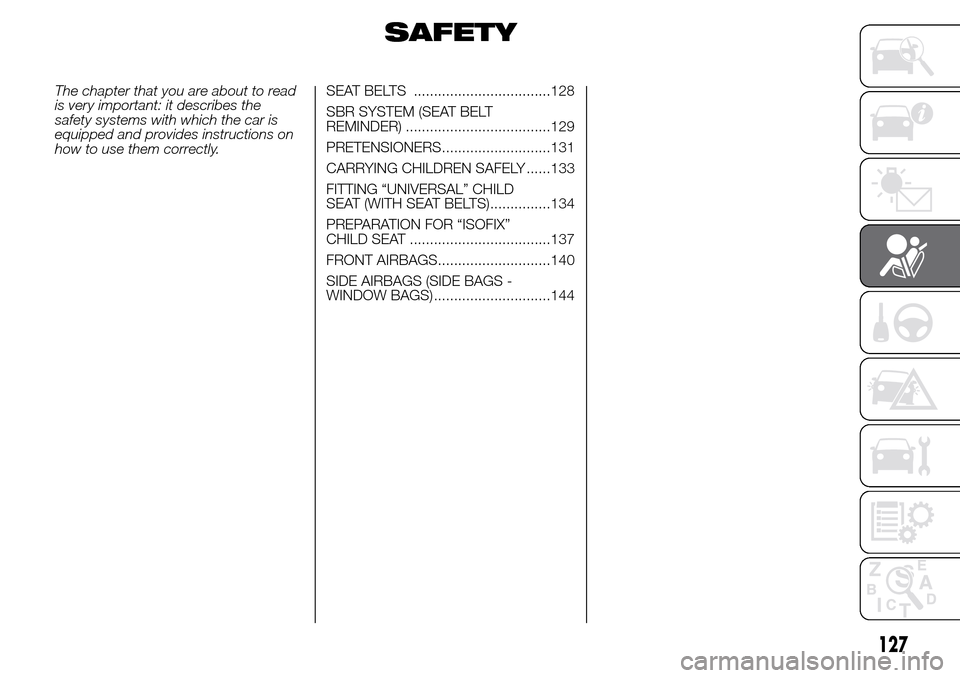
SAFETY
The chapter that you are about to read
is very important: it describes the
safety systems with which the car is
equipped and provides instructions on
how to use them correctly.SEAT BELTS ..................................128
SBR SYSTEM (SEAT BELT
REMINDER) ....................................129
PRETENSIONERS...........................131
CARRYING CHILDREN SAFELY ......133
FITTING “UNIVERSAL” CHILD
SEAT (WITH SEAT BELTS)...............134
PREPARATION FOR “ISOFIX”
CHILD SEAT ...................................137
FRONT AIRBAGS............................140
SIDE AIRBAGS (SIDE BAGS -
WINDOW BAGS) .............................144
127
Page 148 of 288
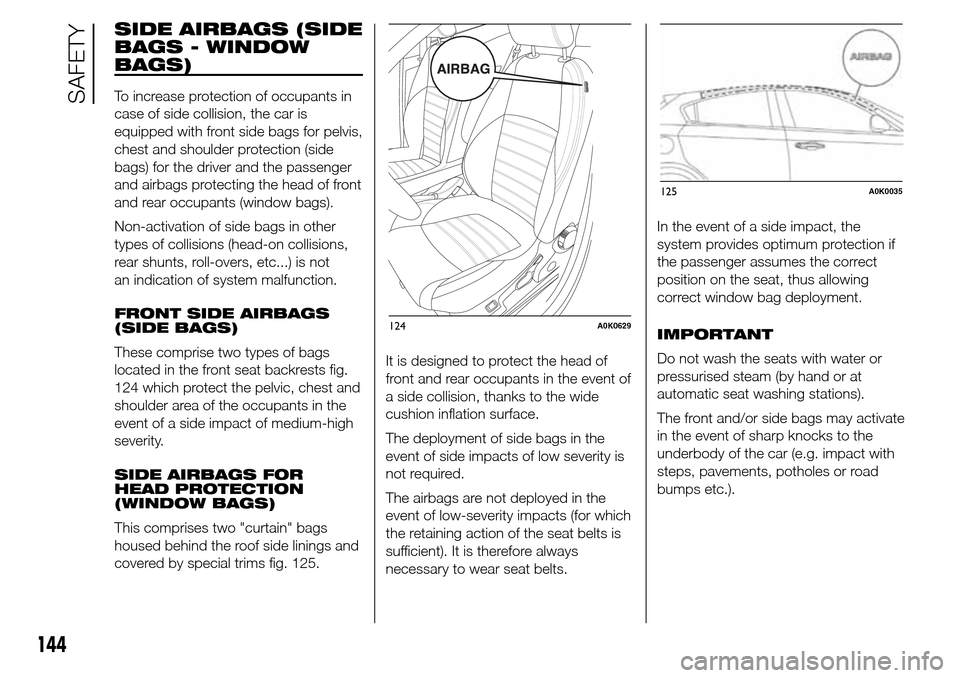
SIDE AIRBAGS (SIDE
BAGS - WINDOW
BAGS)
To increase protection of occupants in
case of side collision, the car is
equipped with front side bags for pelvis,
chest and shoulder protection (side
bags) for the driver and the passenger
and airbags protecting the head of front
and rear occupants (window bags).
Non-activation of side bags in other
types of collisions (head-on collisions,
rear shunts, roll-overs, etc...) is not
an indication of system malfunction.
FRONT SIDE AIRBAGS
(SIDE BAGS)
These comprise two types of bags
located in the front seat backrests fig.
124 which protect the pelvic, chest and
shoulder area of the occupants in the
event of a side impact of medium-high
severity.
SIDE AIRBAGS FOR
HEAD PROTECTION
(WINDOW BAGS)
This comprises two "curtain" bags
housed behind the roof side linings and
covered by special trims fig. 125.It is designed to protect the head of
front and rear occupants in the event of
a side collision, thanks to the wide
cushion inflation surface.
The deployment of side bags in the
event of side impacts of low severity is
not required.
The airbags are not deployed in the
event of low-severity impacts (for which
the retaining action of the seat belts is
sufficient). It is therefore always
necessary to wear seat belts.In the event of a side impact, the
system provides optimum protection if
the passenger assumes the correct
position on the seat, thus allowing
correct window bag deployment.
IMPORTANT
Do not wash the seats with water or
pressurised steam (by hand or at
automatic seat washing stations).
The front and/or side bags may activate
in the event of sharp knocks to the
underbody of the car (e.g. impact with
steps, pavements, potholes or road
bumps etc.).
124A0K0629
125A0K0035
144
SAFETY
Page 149 of 288
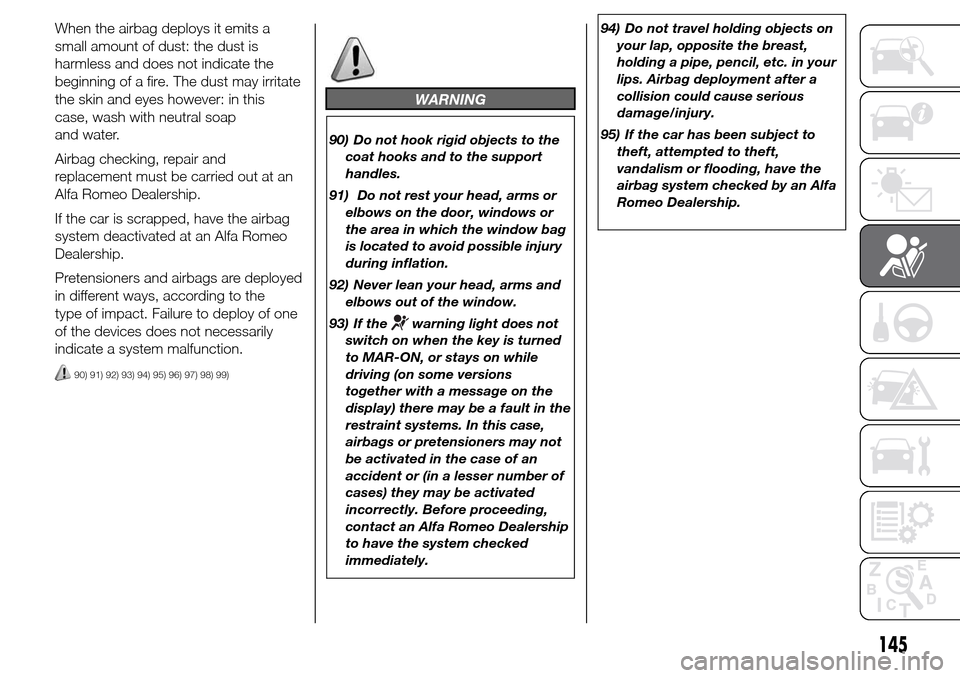
When the airbag deploys it emits a
small amount of dust: the dust is
harmless and does not indicate the
beginning of a fire. The dust may irritate
the skin and eyes however: in this
case, wash with neutral soap
and water.
Airbag checking, repair and
replacement must be carried out at an
Alfa Romeo Dealership.
If the car is scrapped, have the airbag
system deactivated at an Alfa Romeo
Dealership.
Pretensioners and airbags are deployed
in different ways, according to the
type of impact. Failure to deploy of one
of the devices does not necessarily
indicate a system malfunction.
90) 91) 92) 93) 94) 95) 96) 97) 98) 99)
WARNING
90) Do not hook rigid objects to the
coat hooks and to the support
handles.
91) Do not rest your head, arms or
elbows on the door, windows or
the area in which the window bag
is located to avoid possible injury
during inflation.
92) Never lean your head, arms and
elbows out of the window.
93) If the
warning light does not
switch on when the key is turned
to MAR-ON, or stays on while
driving (on some versions
together with a message on the
display) there may be a fault in the
restraint systems. In this case,
airbags or pretensioners may not
be activated in the case of an
accident or (in a lesser number of
cases) they may be activated
incorrectly. Before proceeding,
contact an Alfa Romeo Dealership
to have the system checked
immediately.94) Do not travel holding objects on
your lap, opposite the breast,
holding a pipe, pencil, etc. in your
lips. Airbag deployment after a
collision could cause serious
damage/injury.
95) If the car has been subject to
theft, attempted to theft,
vandalism or flooding, have the
airbag system checked by an Alfa
Romeo Dealership.
145
Page 162 of 288

WARNING
106) Using the levers incorrectly
(levers pushed towards the
dashboard, see fig. 137) could
break them.
107) Never leave children
unattended in the car. Always
remove the ignition key when
leaving the car and take the key
with you.
108) The Launch control function is
only available in Dynamic mode.
Regardless of what is explicitly
indicated in the description of
these modes, the ESC and ASR
systems are deactivated during
operation of the Launch Control
function. This means that vehicle
dynamic control is the sole
responsibility of the driver.
Therefore pay the utmost
attention when using the Launch
Control. Take into account traffic
and road surface conditions and
during manoeuvres make sure
there is enough room in the area
concerned.
SAVING FUEL
Here are some suggestions which can
help you to save fuel and lower harmful
emissions.
GENERAL
CONSIDERATIONS
Car maintenance
Checks and adjustments should be
carried out in accordance with the
“Scheduled Servicing Plan” (see
chapter “Maintenance and care”).
Tyres
Check the tyre pressures at least once
every four weeks: if the pressure is
too low, consumption levels increase as
resistance to rolling is higher.
Unnecessary loads
Do not travel with an overloaded boot.
The weight of the car and its
arrangement greatly affect fuel
consumption and stability.Roof rack/ski rack
Remove the roof rack or the ski rack
from the roof after use. These
accessories lower aerodynamic
penetration and adversely affect
consumption levels. When transporting
particularly large objects, use a trailer
if possible.
Electrical devices
Use the electrical devices only for the
necessary amount of time. The heated
rear window, additional headlights,
screen wipers and heater fan require a
considerable amount of energy;
increasing the current uptake increases
fuel consumption (by up to +25% in
an urban cycle).
Climate control system
Using the climate control system will
increase consumption: use the air vents
when the temperature outside permits.
Devices for
aerodynamic control
The use of non-certified devices for
aerodynamic control may adversely
affect air drag and fuel consumption.
158
STARTING AND DRIVING